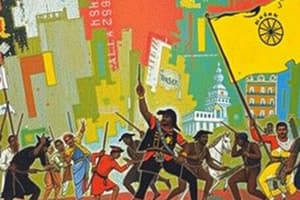Podcast
Questions and Answers
What was the main principle behind the Doctrine of Lapse?
What was the main principle behind the Doctrine of Lapse?
- If the ruler of a dependent state died without a natural heir, his adopted son would not be allowed to occupy the throne. (correct)
- The ruler of a dependent state could adopt a son to occupy the throne.
- The British would provide financial support to the ruler of a dependent state.
- The British Empire in India would recognize the adopted son as the rightful heir.
Which of the following was NOT a consequence of the Doctrine of Lapse?
Which of the following was NOT a consequence of the Doctrine of Lapse?
- The state would be annexed to the British Empire in India.
- The state would be occupied by the British East India Company.
- The ruler of the dependent state would be given a pension.
- The adopted son would be recognized as the rightful heir. (correct)
Why was Nana Saheb not recognized as the heir to the throne of Peshwa Baji Rao II?
Why was Nana Saheb not recognized as the heir to the throne of Peshwa Baji Rao II?
- He was not the natural son of Peshwa Baji Rao II. (correct)
- He was adopted by Peshwa Baji Rao II when he was an adult.
- He was not popular among the people of the state.
- He was not qualified to occupy the throne.
Which of the following states was NOT annexed using the Doctrine of Lapse?
Which of the following states was NOT annexed using the Doctrine of Lapse?
Who introduced the Doctrine of Lapse in India?
Who introduced the Doctrine of Lapse in India?
Which of the following factors contributed to the Indian Rebellion of 1857?
Which of the following factors contributed to the Indian Rebellion of 1857?
Where did the Indian Rebellion of 1857 begin?
Where did the Indian Rebellion of 1857 begin?
Who was declared the emperor of India by the rebels during the Indian Rebellion of 1857?
Who was declared the emperor of India by the rebels during the Indian Rebellion of 1857?
Which of the following figures is considered one of the first martyrs of the Indian independence movement?
Which of the following figures is considered one of the first martyrs of the Indian independence movement?
Which of the following cities was NOT a key site of the Indian Rebellion of 1857?
Which of the following cities was NOT a key site of the Indian Rebellion of 1857?
What was the immediate consequence of the Indian Rebellion of 1857 for the British East India Company?
What was the immediate consequence of the Indian Rebellion of 1857 for the British East India Company?
What was the major impact of the Indian Rebellion of 1857 on the Indian Army?
What was the major impact of the Indian Rebellion of 1857 on the Indian Army?
Which of the following statements BEST describes the significance of the Indian Rebellion of 1857?
Which of the following statements BEST describes the significance of the Indian Rebellion of 1857?
Flashcards are hidden until you start studying
Study Notes
Doctrine of Lapse
- Introduced by Lord Dalhousie as a policy for annexing Indian states.
- Aimed to expand British control over Indian territories by claiming states with rulers who died without a natural heir.
- Adopted sons of rulers were not permitted to ascend to the throne; instead, the state would be annexed to the British Empire.
Impacted States
- Jhansi and Satara are notable states that were annexed under the Doctrine of Lapse.
Nana Saheb and Peshwa Baji Rao II
- Nana Saheb, the adopted son of Peshwa Baji Rao II, was denied recognition as the rightful heir.
- British authorities, under Lord Dalhousie, rejected his claim and refused to grant him the pension due to his status as an adopted son.
Causes of the War
- The Indian Rebellion of 1857, also called the Sepoy Mutiny, was a significant uprising against British colonial rule.
- Triggered by the Enfield rifle's introduction, which used greased cartridges offensive to Hindu and Muslim soldiers.
- Key contributing factors included:
- Economic exploitation by the British East India Company.
- Disregard for Indian customs and traditions.
- Lack of Indian representation in government decisions.
Key Events of the War
- The rebellion ignited on May 10, 1857, in Meerut, where Indian soldiers attacked British officers and initiated a march to Delhi.
- Rebels declared Bahadur Shah Zafar, the last Mughal emperor, as the ruler of India.
- The uprising spread regionally, affecting cities like Lucknow, Kanpur, and Jhansi.
- The conflict lasted over a year, ending with the defeat of Indian forces.
Key Figures of the War
- Bahadur Shah Zafar: Last Mughal emperor, symbolizing rebellion as he was proclaimed emperor by insurgents.
- Mangal Pandey: An early freedom fighter, considered one of the first martyrs of India's independence movement.
- Rani Lakshmibai: Queen of Jhansi, notable for her leadership in regional resistance against British authority.
- Tantia Tope: An Indian leader crucial to the rebellion, who faced execution by British forces.
Consequences of the War
- Marked the end of the Mughal Empire and ushered in direct British governance of India.
- Dissolution of the British East India Company; control shifted directly to the British government.
- Restructuring of the Indian Army with increased recruitment of local soldiers.
- Shift in British governance philosophy, emphasizing greater respect for Indian customs and traditions.
Studying That Suits You
Use AI to generate personalized quizzes and flashcards to suit your learning preferences.




